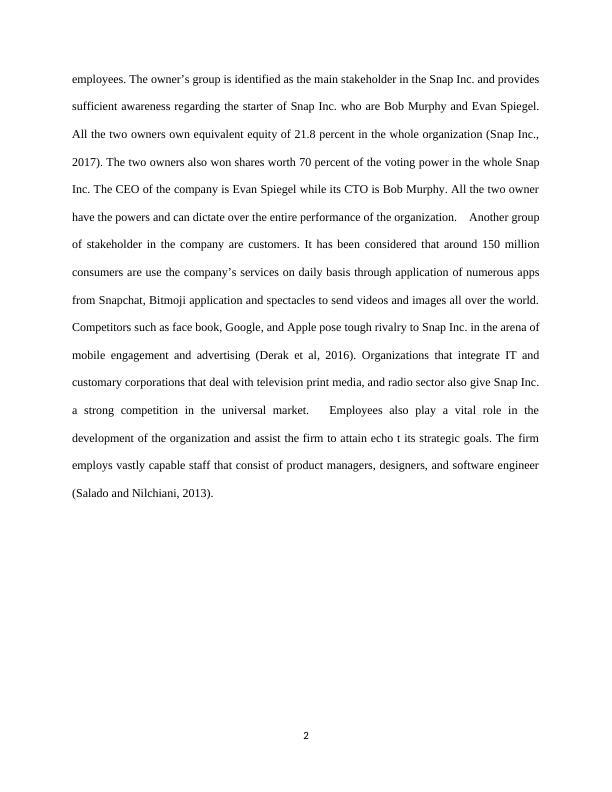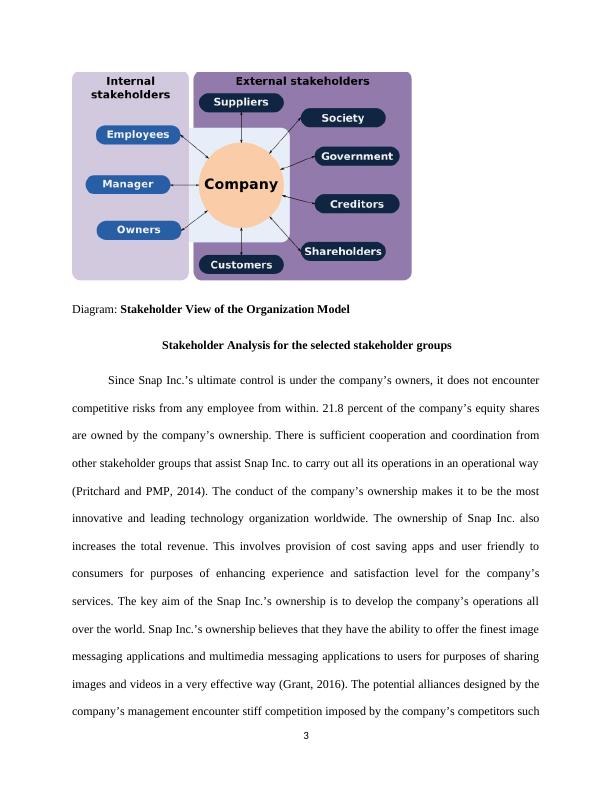Dynamic Strategy and Disruptive Innovation: Snap Inc.
Added on 2023-06-07
10 Pages2874 Words94 Views
Dynamic Strategy and Disruptive Innovation: Snap Inc.
Introduction
Snapchat, one of the most used camera app products on smart phones, has been continuously
improving, attracting new users, and rising to become the most-used teen app in 2016 (Tierno
and Campo, 2005). Daily active users have been consistently growing since 2014 and have
doubled to 150 million since then. However, comparatively speaking, it has only recently caught
up to some of the giant social media websites like that of Instagram and Twitter this year – it’s
still significantly lagging behind Facebook. One thing CEO Evan Spiegel understood is that it’s
not enough to just be good nowadays, you need to be great to continuously succeed. As a result,
they needed to move towards positioning the company to take greater control of the value chain
in which they currently already are a significant part. It was clear it was time to expand, but
how? Snapchat began by deciding to rebrand itself to Snap Inc. in order to expand its image to
become more than just a messaging app. As innovative ideas emerged within Snap Inc.
headquarters, they needed to reinforce the idea that they are much bigger than a cool mobile-only
camera and messaging app. They publicly shared their intentions to grow with the slight
polishing of their vision statement and the surprise launch of their first hardware product - a pair
of Snapchat glasses called Spectacles. These smart glasses are simple sunglasses with an
integrated camera that records videos and syncs with the wearer’s Snapchat account via
Bluetooth for easy capturing and sharing (Jiang, Nunamaker and Zimbra, 2014).
Snap Inc. Stakeholder View of the Organization Model
Basing on the organization model, there are six main stakeholder’s groups in this company.
These stakeholder groups include media, customers, owners, competitors, suppliers, and
1
Introduction
Snapchat, one of the most used camera app products on smart phones, has been continuously
improving, attracting new users, and rising to become the most-used teen app in 2016 (Tierno
and Campo, 2005). Daily active users have been consistently growing since 2014 and have
doubled to 150 million since then. However, comparatively speaking, it has only recently caught
up to some of the giant social media websites like that of Instagram and Twitter this year – it’s
still significantly lagging behind Facebook. One thing CEO Evan Spiegel understood is that it’s
not enough to just be good nowadays, you need to be great to continuously succeed. As a result,
they needed to move towards positioning the company to take greater control of the value chain
in which they currently already are a significant part. It was clear it was time to expand, but
how? Snapchat began by deciding to rebrand itself to Snap Inc. in order to expand its image to
become more than just a messaging app. As innovative ideas emerged within Snap Inc.
headquarters, they needed to reinforce the idea that they are much bigger than a cool mobile-only
camera and messaging app. They publicly shared their intentions to grow with the slight
polishing of their vision statement and the surprise launch of their first hardware product - a pair
of Snapchat glasses called Spectacles. These smart glasses are simple sunglasses with an
integrated camera that records videos and syncs with the wearer’s Snapchat account via
Bluetooth for easy capturing and sharing (Jiang, Nunamaker and Zimbra, 2014).
Snap Inc. Stakeholder View of the Organization Model
Basing on the organization model, there are six main stakeholder’s groups in this company.
These stakeholder groups include media, customers, owners, competitors, suppliers, and
1

employees. The owner’s group is identified as the main stakeholder in the Snap Inc. and provides
sufficient awareness regarding the starter of Snap Inc. who are Bob Murphy and Evan Spiegel.
All the two owners own equivalent equity of 21.8 percent in the whole organization (Snap Inc.,
2017). The two owners also won shares worth 70 percent of the voting power in the whole Snap
Inc. The CEO of the company is Evan Spiegel while its CTO is Bob Murphy. All the two owner
have the powers and can dictate over the entire performance of the organization. Another group
of stakeholder in the company are customers. It has been considered that around 150 million
consumers are use the company’s services on daily basis through application of numerous apps
from Snapchat, Bitmoji application and spectacles to send videos and images all over the world.
Competitors such as face book, Google, and Apple pose tough rivalry to Snap Inc. in the arena of
mobile engagement and advertising (Derak et al, 2016). Organizations that integrate IT and
customary corporations that deal with television print media, and radio sector also give Snap Inc.
a strong competition in the universal market. Employees also play a vital role in the
development of the organization and assist the firm to attain echo t its strategic goals. The firm
employs vastly capable staff that consist of product managers, designers, and software engineer
(Salado and Nilchiani, 2013).
2
sufficient awareness regarding the starter of Snap Inc. who are Bob Murphy and Evan Spiegel.
All the two owners own equivalent equity of 21.8 percent in the whole organization (Snap Inc.,
2017). The two owners also won shares worth 70 percent of the voting power in the whole Snap
Inc. The CEO of the company is Evan Spiegel while its CTO is Bob Murphy. All the two owner
have the powers and can dictate over the entire performance of the organization. Another group
of stakeholder in the company are customers. It has been considered that around 150 million
consumers are use the company’s services on daily basis through application of numerous apps
from Snapchat, Bitmoji application and spectacles to send videos and images all over the world.
Competitors such as face book, Google, and Apple pose tough rivalry to Snap Inc. in the arena of
mobile engagement and advertising (Derak et al, 2016). Organizations that integrate IT and
customary corporations that deal with television print media, and radio sector also give Snap Inc.
a strong competition in the universal market. Employees also play a vital role in the
development of the organization and assist the firm to attain echo t its strategic goals. The firm
employs vastly capable staff that consist of product managers, designers, and software engineer
(Salado and Nilchiani, 2013).
2

Diagram: Stakeholder View of the Organization Model
Stakeholder Analysis for the selected stakeholder groups
Since Snap Inc.’s ultimate control is under the company’s owners, it does not encounter
competitive risks from any employee from within. 21.8 percent of the company’s equity shares
are owned by the company’s ownership. There is sufficient cooperation and coordination from
other stakeholder groups that assist Snap Inc. to carry out all its operations in an operational way
(Pritchard and PMP, 2014). The conduct of the company’s ownership makes it to be the most
innovative and leading technology organization worldwide. The ownership of Snap Inc. also
increases the total revenue. This involves provision of cost saving apps and user friendly to
consumers for purposes of enhancing experience and satisfaction level for the company’s
services. The key aim of the Snap Inc.’s ownership is to develop the company’s operations all
over the world. Snap Inc.’s ownership believes that they have the ability to offer the finest image
messaging applications and multimedia messaging applications to users for purposes of sharing
images and videos in a very effective way (Grant, 2016). The potential alliances designed by the
company’s management encounter stiff competition imposed by the company’s competitors such
3
Stakeholder Analysis for the selected stakeholder groups
Since Snap Inc.’s ultimate control is under the company’s owners, it does not encounter
competitive risks from any employee from within. 21.8 percent of the company’s equity shares
are owned by the company’s ownership. There is sufficient cooperation and coordination from
other stakeholder groups that assist Snap Inc. to carry out all its operations in an operational way
(Pritchard and PMP, 2014). The conduct of the company’s ownership makes it to be the most
innovative and leading technology organization worldwide. The ownership of Snap Inc. also
increases the total revenue. This involves provision of cost saving apps and user friendly to
consumers for purposes of enhancing experience and satisfaction level for the company’s
services. The key aim of the Snap Inc.’s ownership is to develop the company’s operations all
over the world. Snap Inc.’s ownership believes that they have the ability to offer the finest image
messaging applications and multimedia messaging applications to users for purposes of sharing
images and videos in a very effective way (Grant, 2016). The potential alliances designed by the
company’s management encounter stiff competition imposed by the company’s competitors such
3

End of preview
Want to access all the pages? Upload your documents or become a member.
Related Documents
Management and Organisation Assignment : Snapchatlg...
|11
|2237
|83
Management and Organization - Doclg...
|12
|2300
|45
Study Analysis Snap Inc.'s Stakeholder Analysislg...
|13
|3088
|1561
Snap Inc. Stakeholder Analysislg...
|13
|3134
|441
Stakeholders Analysis - Snap Inclg...
|12
|2419
|108
Strategic Management of Snap Inc.: Organizational Structure, Modern Management Approach, and SWOT Analysislg...
|12
|2642
|487
